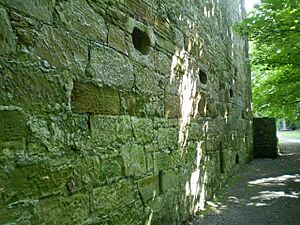Kinneil House facts for kids
Quick facts for kids Kinneil House |
|
|---|---|
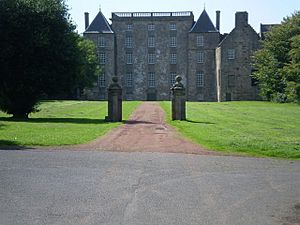 |
|
| Location | Bo'ness, Scotland |
| Built | 1553 |
| Built for | James Hamilton, 2nd Lord Hamilton, 1st Earl of Arran |
| Governing body | Historic Environment Scotland |
Kinneil House is an amazing historic building located near Bo'ness in central Scotland. For a long time, it was the main home of the powerful Hamilton family in this part of Scotland. This special house was almost torn down in 1936! Luckily, old paintings from the 1500s were found on its walls, saving it.
Today, Historic Environment Scotland looks after Kinneil House. The main part of the house you see now was built in 1677. It stands on the remains of an even older building from the 1400s or 1500s, which was a tower house. You can still see small openings called "gunloops" that were used for early cannons. A smaller part of the house, built in the mid-1500s, holds the famous painted rooms. Kinneil House is so important that it's protected as a Category A listed building.
The house is in a public park. This park also has a section of the ancient Roman Antonine Wall. It's the only place where you can see the remains of a Roman fortlet from the Antonine Wall.
Contents
Kinneil House: Early Days
The land around Kinneil, along with other areas, was given to Walter Fitz Gilbert by Robert the Bruce way back in 1323. Walter Fitz Gilbert was an ancestor of the Hamilton family. Records from 1474 mention a castle called "Kynneil called Craig Lyown." This area also had saltpans, which helped the estate earn money. The old Castle of Lyon might have been near the sea.
Kinneil had a deer park very early on. In 1503, James IV sent someone to get deer nets from Kinneil for Falkland Palace. James IV even visited Kinneil in 1508 to see Lord Hamilton's horses.
Some parts of an older castle might be built into the current Kinneil House. This older castle replaced the one at Snab. James Hamilton, 1st Earl of Arran passed away at Kinneil in 1529. He wanted to be buried in Hamilton. There was an old church near the palace, which is now a ruin without a roof. One of its bells is kept in the Kinneil Museum. It has an old Latin message on it. A large stone cross from the church is also kept with the palace.
Regent Arran's Time
The east wing of Kinneil House was built by James Hamilton, 2nd Earl of Arran. He was the Governor, or Regent, of Scotland after James V of Scotland died. Coal from Kinneil was sent to Leith for Edinburgh Castle. Wood for repairs at Kinneil, also called "Craig Lyon" then, came from Leith in 1545. Arran's wife, Margaret Douglas, visited Kinneil often.
Building costs for Kinneil were written down in royal records. Wood for roofs, floors, and panels was sent by boat in 1549 and 1550. Around this time, a monk named Friar Mark wrote a "History of the Hamiltons."
The garden was improved in 1553 with new plants like hedges and marjoram. Trees were brought from Fife and Strathearn. In September 1553, Arran gave money to the masons who were laying the foundations for another part of the palace. One mason, Thomas Bargany, received extra money for clothes. The well for the house is now hidden under the floor of the east wing.
The beautiful 16th-century painted rooms and a stone with the Hamilton family crest show Arran's special French honors. This stone also has the Hamilton family motto, "Through!", and his wife's motto, "Lock Sickar," meaning secure. One painted room, called the Arbour Room, looks like a fancy tapestry. It shows scenes like Samson and Delilah and Abraham and Isaac. The other room has scenes from the Parable of the Good Samaritan. We don't know who the painter was, but some think a French painter from Edinburgh was involved. These paintings might have been a way to talk about the power of women, perhaps referring to Mary of Guise and Mary, Queen of Scots.

In February 1560, French soldiers attacked and burned Kinneil House. In 1562, James Hepburn, Earl of Bothwell came to Kinneil to make peace with James Hamilton, 3rd Earl of Arran. It was said that Bothwell suggested they kidnap Mary, Queen of Scots. A few days later, on Easter Day, the Earl of Arran, who had mental health issues, escaped from his room at Kinneil using sheets as a rope. He went to Falkland Palace to tell the queen about the plot.
After a battle in October 1562, Arran's father, the Duke of Châtellerault, had to keep George Gordon at Kinneil. Gordon was the son of a powerful Earl who had lost his lands.
Royal Visits and Changes
Regent Lennox damaged Kinneil House in May 1570. He used gunpowder and ruined the lands after a Hamilton family member assassinated Regent Moray in Linlithgow. English soldiers helped Lennox.
James VI reduced the Hamilton family's power in 1579. The Duke's wife, Margaret Douglas, and daughter were brought to Kinneil. In 1581, the king gave their lands to James Stewart. This new Earl often lived at Kinneil. For a time, Kinneil was even called Arran House.
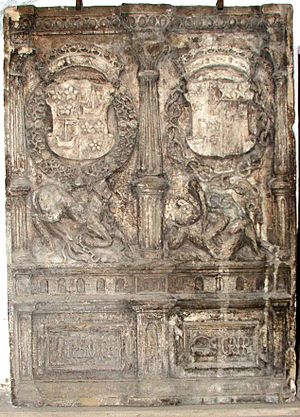
King James VI stayed at Kinneil in May 1582. He met an envoy from the Duke of Guise who brought gifts of horses and gunpowder. This visit was controversial because the envoy was linked to a terrible event in France.
After a political event called the Raid of Ruthven, the Earl of Arran was kept at Kinneil. When that government fell, James VI came to Kinneil to have a banquet with Arran in November 1583. Later that month, Ludovic Stewart, the son of the King's favorite, arrived from France and met the King at Kinneil. In April 1584, the captured Earl of Gowrie was brought to Kinneil. He stayed five days before being taken to Stirling for trial.
James Hamilton, 3rd Earl of Arran returned to Kinneil House in 1585. King James VI held court at Kinneil again at Christmas in 1588. He was a guest of John Hamilton. The King played card games with his English courtier, Roger Aston.
Later History of Kinneil House
The Arbour Room was redecorated around 1620 for James Hamilton, 2nd Marquess of Hamilton and his wife Ann Cunningham. You can still see parts of the Cunningham family crest in the paintings. This work was likely done by Valentine Jenkin, a painter from Glasgow.
In October 1641, several important figures, including the Earl of Argyll and the Marquess of Hamilton, had to flee from Edinburgh to Kinneil because of a conspiracy.
When Ann Cunningham passed away in 1644, she left Kinneil, with its new tapestries and furnishings, to her son, James, 1st Duke of Hamilton. She had worked hard to make the coal mines and salt pans profitable.
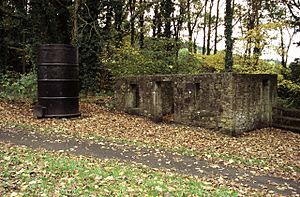
The main house was rebuilt in 1677 by William Douglas, 3rd Duke of Hamilton. He gave it a new, grand look with stone staircases. An inventory from 1688 lists the names of rooms in the house. The front door opened into a large hall, and a grand staircase led to the dining room above.
In 1700, the new Duchess of Hamilton, Elizabeth Gerard, came to stay at Kinneil. The 4th Duke of Hamilton ordered that the "two pavilions be whitened, as the body of the house is."
Over time, the Hamilton family used the house less, as they earned more money from the mines and port. In the late 1700s, John Roebuck, who started the Carron Iron Works, lived at Kinneil House. During this time, the famous engineer James Watt worked on his steam engine in a small cottage next to the house. Between 1809 and 1828, the 9th Duke let the philosopher Dugald Stewart use the house.
By 1936, the Hamiltons had left the house. The local council in Bo'ness started to tear it down. But then, Stanley Cursiter, who was in charge of the National Galleries of Scotland, heard that old wall paintings had been found! The Ministry of Works quickly saved the wing with the paintings. The paintings were restored, and now the whole building is cared for by Historic Environment Scotland.
The White Lady Ghost
Kinneil House is said to be haunted by a "White Lady." People believe she is the ghost of Lady Alice, who supposedly jumped from the building in the 1600s to escape her cruel husband. Lady Alice, or Ailie, was traditionally thought to haunt the nearby Gil Burn glen. The ghost story was written down by Maria Edgeworth in 1823. She described the house as an "old but white-washed castle-mansion." Her host told her about "Lady Lilyburn" who "flutters on top of the castle and leaps into the sea, or stomps around the house in boots frightening the maids."
The Antonine Wall at Kinneil
For a long time, people thought there might have been a Roman fort near Kinneil House. Sir George Macdonald, a famous archaeologist, thought there might be a small fortlet nearby.
In July 1961, two sites in Bo'ness were dug up by archaeologists. This followed earlier digs in 1960. The first site was in a field near Kinneil House. The digging showed blocks of stone that were once part of the wall's base.
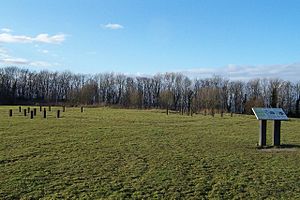
In the 1970s, a Roman fortlet was found, along with two timber buildings. A short part of the Antonine Wall's rampart has been rebuilt there. Kinneil is the only place where you can see a Roman fortlet from the Antonine Wall today. Among the things found at the site was a Roman horse harness loop. A digital model of the fortlet has been made.
You can even find a detailed video online of the copper alloy harness fitting. A fine leather shoe from the fortlet has also been digitally recreated. A single Roman coin was also discovered.
In 2018, nine new digging areas were opened at Kinneil. These revealed the remains of a paved surface, possibly part of the Roman Military Way, which was a road for soldiers.


